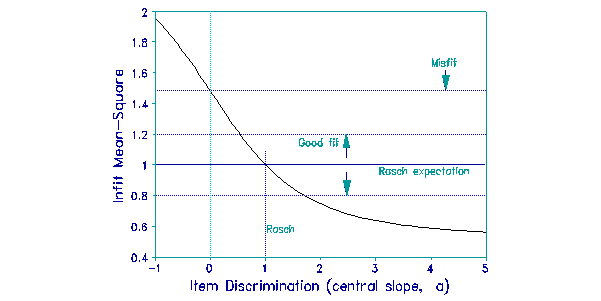
Descriptive approaches to item analysis parameterize differing central slopes in the empirical item characteristic curves (ICCs) as Item Discrimination, a. Rasch approaches detect differing slopes with quality-control fit statistics, most commonly the Infit mean-square (INFIT) statistic, an information-weighted chi-square statistic divided by its degrees of freedom. What is the numerical correspondence between INFIT and discrimination?

Before such an investigation can have meaning, obvious malfunctions in the data such as guessing, carelessness, data entry errors and mis-scoring are screened out. Then, Figure below shows various idealized ICCs, plotted in the region of the latent variable on which the item is targeted. The box covers the region equivalent to p=.15 to p=.85 of the Rasch ogive, i.e., -1.7 to +1.7 logits. Discrimination a=1 is the Rasch ogive for a dichotomous item, and is shown extending beyond the box. Empirical ICCs outside the box are better diagnosed by the Outfit Mean-square statistics and point-biserial correlation.

A simulation study produces the relationship shown in the Figure above. Central item discriminations from 0.5 to 1.7 produce good fit to the Rasch model, provided the part of the ICC away from the center is in reasonable conformance. This suggests that, for reasonably homogeneous items, empirical differences in item discrimination have no meaningful impact on measurement.
John Michael Linacre

First, divide the sample into two strata (high and low). Second, compute the percentage of
each strata succeeding on each item. Third, locate the two percentage points, one on each side
of the nomograph. Fourth, the item discrimination is at the point where a line joining the two points
crosses the middle line.
C.H. Lawshe, Jr. Principles of Personnel Testing. New York: McGraw-Hill, 1948, p. 190
Item Discrimination and Infit Mean-Squares. Linacre, J.M. … Rasch Measurement Transactions, 2000, 14:2 p.743
| Forum | Rasch Measurement Forum to discuss any Rasch-related topic |
Go to Top of Page
Go to index of all Rasch Measurement Transactions
AERA members: Join the Rasch Measurement SIG and receive the printed version of RMT
Some back issues of RMT are available as bound volumes
Subscribe to Journal of Applied Measurement
Go to Institute for Objective Measurement Home Page. The Rasch Measurement SIG (AERA) thanks the Institute for Objective Measurement for inviting the publication of Rasch Measurement Transactions on the Institute's website, www.rasch.org.
| Coming Rasch-related Events | |
|---|---|
| Jan. 16 - Feb. 13, 2025, Fri.-Fri. | On-line workshop: Rasch Measurement - Core Topics (E. Smith, Winsteps), www.statistics.com |
| Apr. 8 - Apr. 11, 2026, Wed.-Sat. | National Council for Measurement in Education - Los Angeles, CA, ncme.org/events/2026-annual-meeting |
| Apr. 8 - Apr. 12, 2026, Wed.-Sun. | American Educational Research Association - Los Angeles, CA, www.aera.net/AERA2026 |
| May. 15 - June 12, 2026, Fri.-Fri. | On-line workshop: Rasch Measurement - Core Topics (E. Smith, Winsteps), www.statistics.com |
| June 19 - July 25, 2026, Fri.-Sat. | On-line workshop: Rasch Measurement - Further Topics (E. Smith, Winsteps), www.statistics.com |
The URL of this page is www.rasch.org/rmt/rmt142a.htm
Website: www.rasch.org/rmt/contents.htm